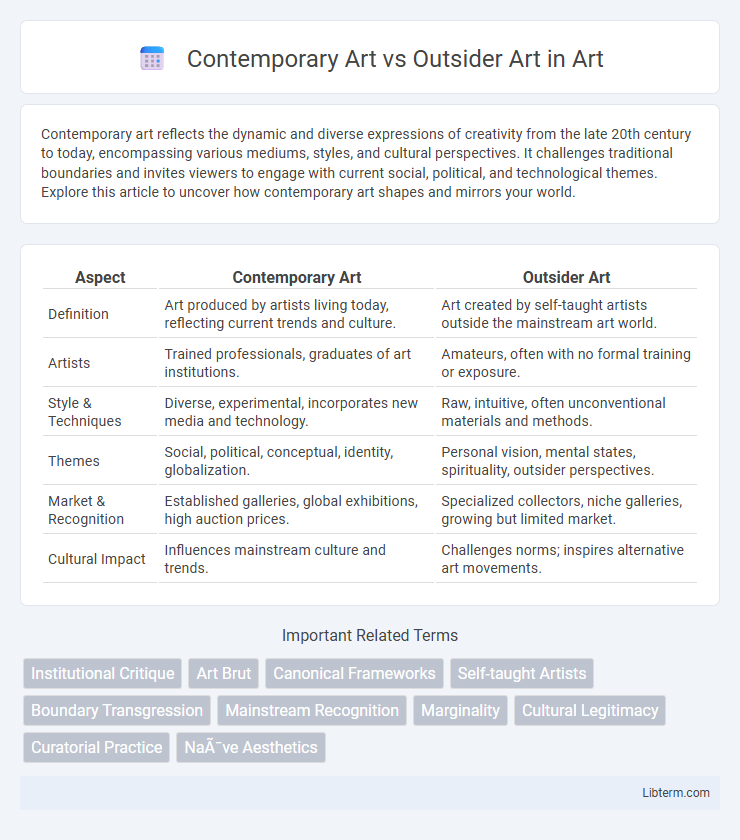Contemporary art reflects the dynamic and diverse expressions of creativity from the late 20th century to today, encompassing various mediums, styles, and cultural perspectives. It challenges traditional boundaries and invites viewers to engage with current social, political, and technological themes. Explore this article to uncover how contemporary art shapes and mirrors your world.
Table of Comparison
| Aspect | Contemporary Art | Outsider Art |
|---|---|---|
| Definition | Art produced by artists living today, reflecting current trends and culture. | Art created by self-taught artists outside the mainstream art world. |
| Artists | Trained professionals, graduates of art institutions. | Amateurs, often with no formal training or exposure. |
| Style & Techniques | Diverse, experimental, incorporates new media and technology. | Raw, intuitive, often unconventional materials and methods. |
| Themes | Social, political, conceptual, identity, globalization. | Personal vision, mental states, spirituality, outsider perspectives. |
| Market & Recognition | Established galleries, global exhibitions, high auction prices. | Specialized collectors, niche galleries, growing but limited market. |
| Cultural Impact | Influences mainstream culture and trends. | Challenges norms; inspires alternative art movements. |
Defining Contemporary Art
Contemporary art refers to artworks produced by living artists that reflect current cultural, social, and political themes, emphasizing innovation and diverse media. It often engages with global issues and contemporary life through conceptual approaches and experimental techniques. The term contrasts with outsider art, which is created outside the mainstream art world, usually by self-taught artists without formal training.
What is Outsider Art?
Outsider Art refers to artworks created by self-taught artists who operate outside the traditional boundaries of the formal art world, often lacking academic training and mainstream exposure. This genre emphasizes raw, unfiltered creativity that stems from personal vision or unconventional perspectives, frequently produced by individuals with mental health conditions or isolated from cultural norms. Unlike Contemporary Art, which is defined by current trends and institutional recognition, Outsider Art is valued for its authenticity and originality beyond established artistic conventions.
Historical Backgrounds of Both Movements
Contemporary art emerged in the mid-20th century, reflecting cultural shifts and technological advancements, with roots in modernism and postmodernism. Outsider art, also known as Art Brut, was coined by Jean Dubuffet in the 1940s to describe works created outside conventional art institutions, often by self-taught or marginalized artists. The historical divide highlights contemporary art's engagement with mainstream cultural dialogues, while outsider art emphasizes raw, uninfluenced creativity beyond academic training.
Artistic Techniques and Mediums
Contemporary art employs a diverse range of techniques and mediums, including digital media, installations, video art, and mixed media, reflecting current cultural and technological trends. Outsider art, often created by self-taught artists outside the mainstream art world, emphasizes raw, unconventional techniques using found materials and non-traditional tools, resulting in highly individualistic and tactile artworks. The contrast highlights how contemporary artists frequently integrate advanced technology and conceptual frameworks, whereas outsider artists prioritize intuitive expression and untrained craftsmanship.
Themes and Subject Matter
Contemporary art explores diverse themes such as identity, technology, and social issues, often reflecting current cultural and political contexts through conceptual and experimental approaches. Outsider art centers on raw, intuitive expressions driven by personal experience, mental health, or isolation, frequently created outside formal art institutions. While contemporary art engages broad societal dialogues, outsider art emphasizes individual, often marginalized perspectives and deeply personal narratives.
Cultural Context and Influence
Contemporary art reflects the diverse cultural, social, and political contexts of mainstream society, often engaging with current global issues and trends to challenge traditional norms and provoke dialogue. Outsider art, created outside the established art world and often by self-taught artists, embodies personal, raw, and unconventional expressions rooted in individual experiences or marginalized communities. The influence of contemporary art is shaped by institutional validation and international art markets, while outsider art gains significance through its authenticity and unique perspectives on culture and identity.
The Role of Formal Training
Contemporary art typically involves artists with formal training from recognized institutions, which influences their techniques, theoretical frameworks, and access to galleries or exhibitions. Outsider art is created by self-taught artists who operate outside the conventional art world, often expressing raw, uninhibited creativity unconstrained by academic rules. The role of formal training therefore distinguishes these two categories by shaping the artists' methodologies, exposure, and reception within the art community.
Market Value and Collectability
Contemporary Art commands high market values driven by prominent galleries, auction records, and celebrity artists, making it highly sought after by collectors worldwide. Outsider Art, characterized by self-taught creators outside the mainstream, often exhibits unpredictable market trends but has gained increased recognition, leading to niche collectability and specialized auction houses. Collectors view Contemporary Art as investment assets, while Outsider Art appeals for its raw authenticity and unique cultural narratives, influencing their respective market dynamics.
Public Reception and Critique
Contemporary art often receives extensive public attention and critical analysis within established art institutions, reflecting its integration into mainstream cultural dialogues and market systems. Outsider art, created by self-taught artists outside traditional art circles, tends to evoke niche public curiosity and empathetic critique, highlighting raw creativity and unconventional perspectives. Public reception of outsider art frequently emphasizes authenticity and emotional impact, contrasting with contemporary art's emphasis on conceptual complexity and trend alignment.
Blurring Boundaries: Future Perspectives
Contemporary art and outsider art increasingly blur boundaries through the integration of unconventional materials and diverse cultural narratives that challenge traditional artistic hierarchies. Emerging technologies like AI and virtual reality enable artists from both domains to expand creative possibilities, fostering hybrid art forms that disrupt rigid classifications. Future perspectives highlight institutional shifts toward inclusivity, recognizing the value of outsider artists alongside established contemporary creators in reshaping the art landscape.
Contemporary Art Infographic

 libterm.com
libterm.com